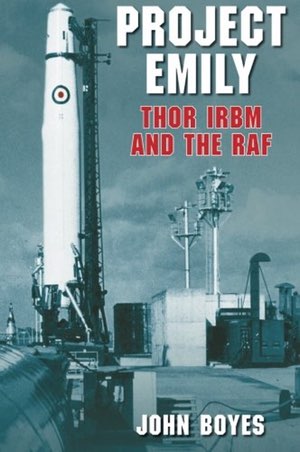Review: Project Emilyby Joseph T. Page II
|
| When the ink on the contract was finally dry, it would be foolhardy to assume that anyone involved in the missile’s development would have correctly predicted Thor’s eventual longevity. |
The first striking fact the reader will notice is more than adequate coverage of the history of the ballistic missile. Boyes paces the story appropriately, beginning with Nazi Germany’s development of the V-2, the Army-Air Force competition for the first IRBM (Jupiter vs. Thor), and General Bernard Schriever’s deft management of the concurrent IRBM and ICBM projects. The core of the book, however, is the British perspective of Thor deployment on their home soil. Documentation within the RAF and British government archives give excellent vantage points to see how the RAF and the local population felt about deploying a “foreign-grown” weapon system. At times, Boyes uncovers some excellent unintentionally dark humor:
“…Overall, the [US/UK] relationship seems to have been good even though the mere presence of the missiles almost guaranteed the annihilation of the local population in a nuclear exchange, although the finality of this was sometimes misunderstood. A farmer local to North Pickenham requested… that he be given suitable warning of an attack so that he could move his cattle to a safer location.”
The majority of information within the book is, understandably, British-centric. This does not detract from the material presented. A few criticisms exist, however. The appendices seem a bit disjointed from the rest of the material, a sort-of hodgepodge of factoids. The photographic inset has many good photos, yet some chapters would have been best served by diagrams of a Thor launch site or side-view of a missile located within the text. Finally, no strong British personalities stand out in either the text or photographs. As a corollary, in many other US missile books, when General Schriever is mentioned, you can bet seeing on a picture of Bennie standing next to his rockets! (He even makes an appearance on the third page of photos here.) These are minor points to be sure, but ones that would strengthen the representation of the RAF in the Thor program’s history.
Missile geeks and Cold War history buffs will find the chapter on the Cuban Missile Crisis illuminating, detailing the actions in the British Isles while the Soviet missiles of October were splayed across newspaper front pages around the world. The RAF coolly maintained Thor’s alert status during the crisis while continuing on with life: No. 102 (SM) Squadron held an open house (minus the liquid oxygen loading), and No. 226 (SM) Squadron held their annual Halloween party.
The United States Air Force owes a debt of gratitude to John Boyes for recording the origin story for Thor, as no American authors have taken up the charge. With the end of the Delta program coming nigh (see “Bringing Asgard to Earth: Making a Thor Heritage District at Vandenberg”, The Space Review, January 4, 2016), space aficionados interested in the legacy of Thor will want a copy of Project Emily for their bookshelves.
